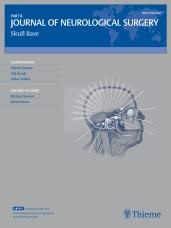In The News
J Neurol Surg B 2017; 78(S 01): S1-S156

DOI: 10.1055/s-0037-1600602
Oral Presentations
Georg Thieme Verlag KG Stuttgart · New York
12-year Retrospective Analysis of 2,993 Consecutive Skull Base Cases 02 March 2017
Perry T. Mansfield1, Hannah G. Goldman1, Natalya Sarkisova1
- 1 Senta Clinic, San Diego, California, United States
Objective: To analyze, compile and report a 12-year retrospective and ongoing series of multidisciplinary skull base case presentations from a series of 1,429 prospective cases and 2,993 total cases recorded between the months of January 2004 and July 2016.
Methods: Our patient data was recorded from regional biweekly CME accredited multidisciplinary skull base conferences. The specialties of neurosurgery, head and neck surgery, plastic surgery, craniofacial surgery, oral-maxillofacial surgery, pathology, oncology, neuroradiology, ophthalmology, radiation oncology, prosthodontics, and other ancillary personnel were represented. The study includes a cataloged series of patient data collected and organized by specific physician, physician specialty, date of presentation, clinical, radiographic and pathologic diagnosis and treatment paradigm. During each patient presentation, pre-treatment symptomatology, gender, age, physical examination, radiographic findings, pathology, diagnosis, treatment strategies and rehabilitative therapies were recorded.
Results: Over the 12-year span, a total of 233 conferences were conducted. Multiple disease specific metrics will be discussed. The average age of the patients presented was 56.13 years old, with a range of 15 to 97. There were 732 male and 694 female prospective patients. The total number of diagnoses was 211. The most frequent diagnosis was vestibular schwannoma/acoustic neuroma, with 181 occurrences, 12.7% of the total prospective cases presented. Of the presenting physicians, the predominant specialty was head and neck surgery, which presented a total of 838 cases. The average number of cases presented per year was 240.9 and the average number of prospective cases per year was 112.3.
Discussion: Defining the prevalence of disease presenting to a tertiary referral head and neck oncology/ skull base center played an important role in helping the author optimize resource allocation based on disease referral patterns. The data was used to improve patient treatment pathways. Age and gender related diagnoses were incorporated into rehabilitative and support strategies. Patient support group systems were tailored to meet prevalence needs. Improved collaboration is needed between prospective skull base tumor conference recommendations, hospital data portals, radiotherapy and chemotherapy data, and rehabilitative services to analyze and optimize long term disease specific patient survival and maximize quality of life metrics.
